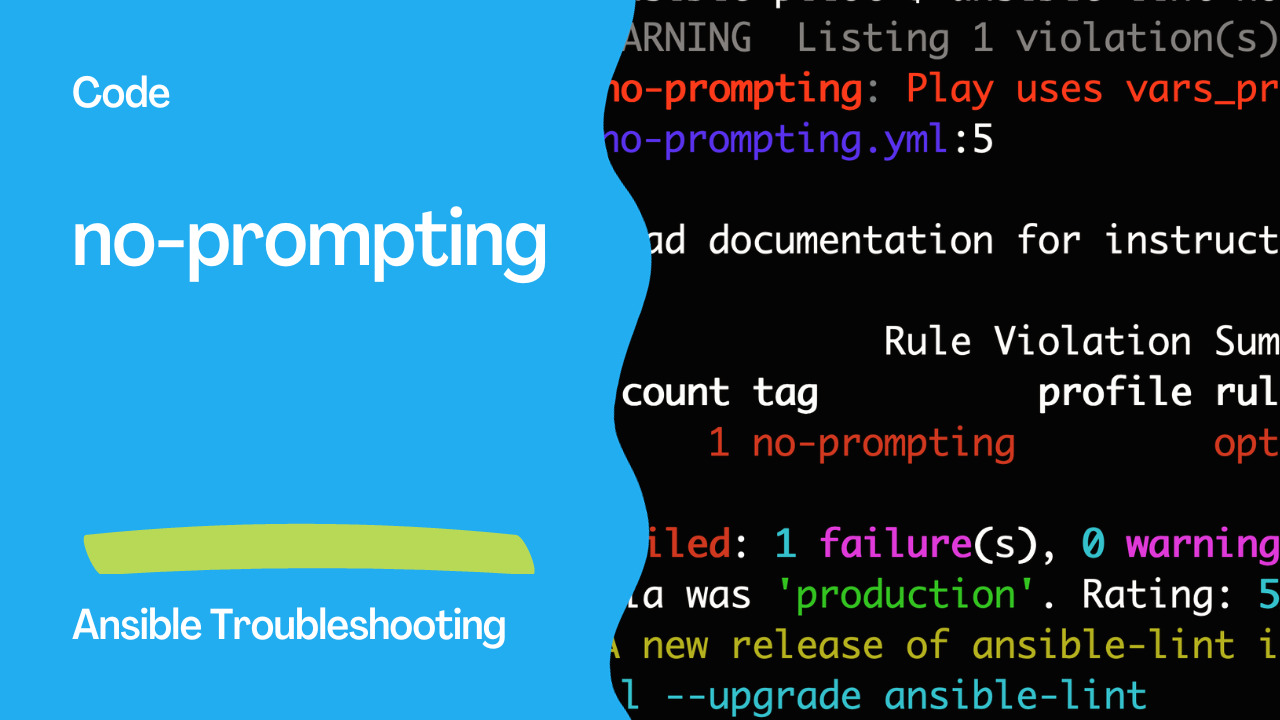Avoid Unnecessary Prompting and Pausing in Ansible Playbooks
Ansible is a powerful automation tool designed to simplify complex IT tasks. While it’s excellent for handling various configurations and deployments, it’s important to create playbooks that can run unattended, particularly in Continuous Integration/Continuous Deployment (CI/CD) pipelines. This article discusses the Ansible playbook error “no-prompting,” which helps ensure that your playbooks are suitable for automated, unattended execution.
The Challenge: Prompts and Pauses
Sometimes, playbooks include user prompts or unnecessary pauses. While these may be useful for manual interventions in some situations, they can become obstacles when you want your playbooks to execute automatically.
For instance, consider a playbook that asks for user credentials via vars_prompt and includes tasks like ansible.builtin.pause to create wait times. In a CI/CD environment, these prompts and pauses can lead to stalled automation pipelines.
The Solution: no-prompting Rule
To prevent these issues, Ansible provides the no-prompting rule in Ansible-lint. This rule checks playbooks for the presence of vars_prompt or the ansible.builtin.pause module, which are prompts or pauses that can disrupt automation. By enabling this rule, you can identify and rectify any occurrences of these elements in your playbooks.
Enabling the Rule
To use the no-prompting rule, you need to enable it in your Ansible-lint configuration file. Here’s an example of how to do it:
enable_list:
- no-prompting
By adding this rule to your enable list, Ansible-lint will check your playbooks for prompts and pauses, helping you ensure they are suitable for automated execution.
Problematic Code
Here’s an example of problematic code in an Ansible playbook:
---
- name: Example playbook
hosts: all
vars_prompt:
- name: username
prompt: What is your username?
private: false
- name: password
prompt: What is your password?
tasks:
- name: Pause for 5 minutes
ansible.builtin.pause:
minutes: 5
- name: Display message
ansible.builtin.debug:
msg: "{{ username }}, {{ password }}"
In this code, user prompts for username and password are included using vars_prompt. Additionally, there’s a pause task that halts playbook execution for 5 minutes.
Ansible Lint Output
WARNING Listing 1 violation(s) that are fatal
no-prompting: Play uses vars_prompt
no-prompting.yml:5
Read documentation for instructions on how to ignore specific rule violations.
Rule Violation Summary
count tag profile rule associated tags
1 no-prompting opt-in
Failed: 1 failure(s), 0 warning(s) on 1 files. Last profile that met the validation criteria was 'production'. Rating: 5/5 star

Correct Code
The correct code, without the prompting and pausing, would look like this:
---
- name: Example playbook
hosts: all
vars:
username: username
password: password
tasks:
- name: Display message
ansible.builtin.debug:
msg: "{{ username }}, {{ password }}"
In the correct code, user prompts and pauses have been removed, making the playbook suitable for unattended execution in automated workflows.
Conclusion
The “no-prompting” rule in Ansible-lint is a valuable tool to ensure your Ansible playbooks are automation-friendly. By eliminating user prompts and pauses, you can create playbooks that seamlessly integrate into CI/CD pipelines, improving efficiency and reliability in your automation processes.
Academy
Learn the Ansible automation technology with some real-life examples in my
Udemy 300+ Lessons Video Course.

My book Ansible By Examples: 200+ Automation Examples For Linux and Windows System Administrator and DevOps

Donate
Want to keep this project going? Please donate
